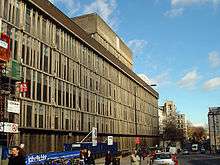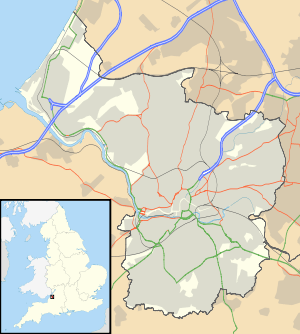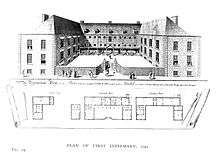Bristol Royal Infirmary
| Bristol Royal Infirmary | |
|---|---|
| University Hospitals Bristol NHS Foundation Trust | |
 Bristol Royal Infirmary and Marlborough Street | |
 Shown in Bristol | |
| Geography | |
| Location | Bristol, England, United Kingdom |
| Coordinates | 51°27′32″N 2°35′47″W / 51.4590°N 2.5963°WCoordinates: 51°27′32″N 2°35′47″W / 51.4590°N 2.5963°W |
| Organisation | |
| Care system | Public NHS |
| Hospital type | Teaching |
| Affiliated university | University of Bristol, Faculty of Health and Social Care University of the West of England |
| Services | |
| Emergency department | Yes Accident & Emergency |
| Speciality | Cardiothoracic services for the South West region, Adult Cystic Fibrosis centre for Severn |
| History | |
| Founded | 1735 |
| Links | |
| Website | http://www.uhbristol.nhs.uk |
| Lists | Hospitals in England |
The Bristol Royal Infirmary, also known as the BRI, is a large teaching hospital situated in the centre of Bristol, England. It has links with the nearby University of Bristol and the Faculty of Health and Social Care at the University of the West of England, also in Bristol. The BRI is one of eight hospitals operated by the University Hospitals Bristol NHS Foundation Trust. It is located next to the Bristol Royal Hospital for Children and the Bristol Heart Institute (BHI).[1]
History
Early history

The Bristol Royal Infirmary was founded by public subscription in 1735, making it one of the oldest infirmaries in the United Kingdom.[2]
In 1904 Sir George White, who gave Bristol its first electric tramway service and established what was to become the Bristol Aeroplane Company, saved the hospital from debts of over £15,000 by increasing the number of subscribed donors and planning a fundraising carnival at Bristol Zoo.[3] White was appointed president of the hospital in 1906. Recognising the need to modernise the hospital building to keep up with innovations in science and medicine, he established a £50,000 fund for a new hospital building.[4] This led to the construction of the Edward VII Memorial Wing which designed by Charles Holden and completed in 1912.[5]
Geoffrey Tovey, serologist and founder of the UK Transplant Service, worked at the hospital shortly before the Second World War.[6] The hospital became part of the National Health Service in 1948 and was greatly extended in the 1960s. The Queen's Building extension opened in 1972, the Bristol Haematology and Oncology Centre, located behind the main hospital building, opened in 1971 and the adjacent Bristol Heart Institute opened in 2009.[7]
Redevelopment
In April 2011, the Trust Board approved an £80 million redevelopment of the hospital, consisting of a new ward block on Terrell Street behind the hospital, the refurbishment of the Queen's building, the conversion of wards in the King Edward building and the decommissioning of the Old Building.[8] In September 2011, it was announced that Laing O'Rourke had signed a contract to redevelop the hospital and build an extension to the Bristol Royal Hospital for Children.[9]
The redevelopment project included purpose-built medical and elderly care admissions units, a state-of-the-art intensive care unit, a surgical floor and a helipad on the roof of the Queen's Building.[10]
The redevelopment also included building a new Welcome Centre at the main entrance of the hospital and a new facade for the Queen's building, which was once voted one of the ugliest buildings in Bristol.[11] Construction began on the new hospital ward block in March 2011, with the demolition of buildings on Terrell Street. The newly completed Welcome Centre was opened to the public in December 2013.[12] In May 2014, the helipad became fully operational and started receiving air ambulances from Bristol and the surrounding area, speeding up transfer times for patients who were being airlifted to the hospital. The HELP Appeal supported the construction of the helipad with a grant of £500,000.[13]
Bristol heart scandal
The Bristol heart scandal, which resulted in the deaths of a number of babies and young children during heart surgery (1984–1995) led to the Kennedy Report into paediatric cardiac surgical services at the hospital. The report led to greater emphasis on clinical governance within the NHS and the publication of the performance ratings of individual heart surgeons.[14]
Archives
The archives of the Bristol Royal Infirmary are held at Bristol Archives (Ref. 35893) (online catalogue). The School of Nursing (Ref. 38973) (online catalogue, online catalogue), records of surgery and the dispensary (Ref. 38990) (online catalogue) and records relating to the 1991 inquiry into children’s heart surgery at the infirmary (Ref. 45591) (online catalogue) are also held at Bristol Archives, as well as photographs (Ref. 40660) (online catalogue). A substantial quantity of material about the history of the infirmary can be found in papers collected by the surgeon Richard Smith (Ref. 35893/36) (online catalogue) and (Ref. 14754) (online catalogue).[15]
See also
References
- ↑ "Bristol Heart Institute Clinical Services". University Hospitals Bristol. 2009. Retrieved 23 November 2017.
- ↑ Munro Smith, p. 6
- ↑ Munro Smith, p. 416
- ↑ Munro Smith, p. 417
- ↑ "Bristol Royal Infirmary, by Charles Holden (1912)". Architects Journal. 10 July 2012. Retrieved 26 April 2018.
- ↑ "Obituary: Geoffrey Tovey". The Telegraph. 20 December 2001. Retrieved 1 April 2018.
- ↑ "Her Royal Highness The Princess Royal to officially open the Bristol Heart Institute". University Hospitals Bristol NHS Foundation Trust. 24 September 2009. Retrieved 14 December 2017.
- ↑ "Who We Are and What We Do | University Hospitals Bristol NHS Foundation Trust". Uhbristol.nhs.uk. 27 September 2011. Retrieved 17 March 2013.
- ↑ "£80m Bristol hospital project for Laing O'Rourke". The Construction Index. 28 September 2011. Retrieved 26 April 2018.
- ↑ "Redevelopment projects | University Hospitals Bristol NHS Foundation Trust". Uhbristol.nhs.uk. Retrieved 17 March 2013.
- ↑ "Bristol Royal Infirmary facade design winner announced". BBC. 30 July 2013. Retrieved 27 April 2018.
- ↑ "Doors to open at new Welcome Centre". University Hospitals Bristol. Retrieved 26 March 2018.
- ↑ "Bristol Royal Infirmary". Helicopter Emergency Landing Pads Appeal. Retrieved 26 March 2018.
- ↑ Inquiry, Bristol Royal Infirmary (1 July 2001). "The Inquiry into the management of care of children receiving complex heart surgery at the Bristol Royal Infirmary". webarchive.nationalarchives.gov.uk.
- ↑ "Bristol Royal Infirmary, Bristol". National Archives. Retrieved 26 April 2018.
Sources
- Munro Smith, George (1917). A history of the Bristol Royal Infirmary (PDF). J.W. Arrowsmith.